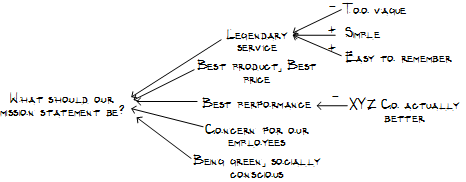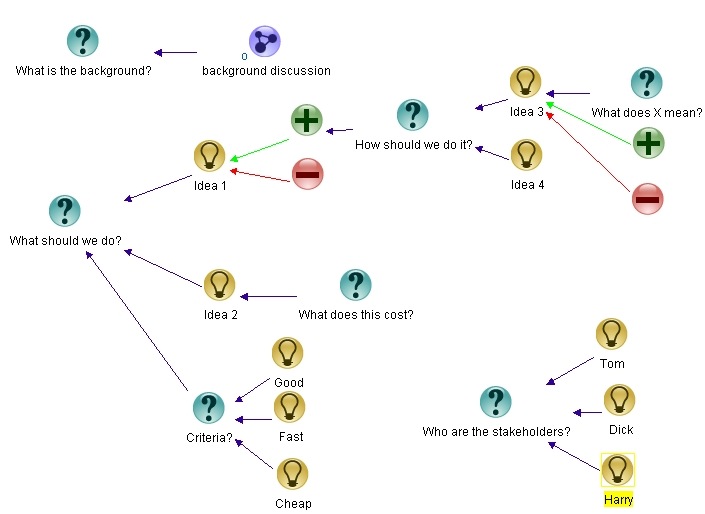Some problems are so complex that you have to be highly intelligent and well informed just to be undecided about them.
– Laurence Peter
Dialogue Mapping: Building Shared Understanding of Wicked Problems, Conklin, Jeff
However you’re paying attention to the current external environment — the nightly news, newspapers, blogs, Twitter, or the Daily Show — it’s a grim time. While there is a great deal of noise, there’s not as much light as you might like. Dialogue Mapping, by Jeff Conklin, is one effort to equip us with tools for creating more light. While Conklin started out doing research on software for group decision support that research led him into some unexpected places of organizational dynamics and problem structure. He starts with the notion of “fragmentation” as the barrier to coherent organizational action. He defines fragmentation as “wicked problems x social complexity.”
I’m often surprised that the term “wicked problem” hasn’t become more common. The notion and the term have actually been around for decades. Horst Rittel at Berkeley coined the term in a paper, “Issues as Elements of Information Systems,” in the 1970s. Rittel identified six criteria that distinguish a particular problem as a wicked one:
- You don t understand the problem until you have developed a solution
- Wicked problems have no stopping rule
- Solutions to wicked problems are not right or wrong
- Every wicked problem is essentially unique and novel
- Every solution to a wicked problem is a one-shot operation
- Wicked problems have no given alternative solutions
Compare wicked problems with tame problems. A tame problem:
- Has a well-defined and stable problem statement
- Has a definite stopping point
- Has a solution that can be objectively evaluated as right or wrong
- Belongs to a class of similar problems that are all solved in the same similar way
- Has solutions that can be easily tried and abandoned
- Comes with a limited set of alternative solutions
Obviously there are degrees of wickedness/tameness. Nevertheless, the real world of politics, urban planning, health care, business, and a host of other domains is filled with wicked problems, whether we acknowledge them as such or not. All too often, wicked problems go unrecognized as such. If you do recognize a problem as a wicked one, you can choose to attempt to tame it to the point where you might be able to solve it. Some ways to tame a wicked problem include:
- Lock down the problem definition
- Assert that the problem is solved
- Specify objective parameters by which to measure the solution s success
- Cast the problem as just like a previous problem that has been solved
- Give up on trying to get a good solution to the problem
- Declare that there are just a few possible solutions, and focus on selecting from among these options
These are the kinds of problem management strategies frequently seen in organizations. Conklin provides a good case that we and organizations would be better off if we were more explicit and mindful that this is what we were up to. That isn’t always possible and brings us to Conklin’s second element driving fragmentation: social complexity. Independently of the problem features that make them wicked problems, problems also exist in environments of multiple stakeholders with differing worldviews and agendas.
This social complexity increases the challenge of discovering or inventing sufficient shared ground around a problem to make progress toward a resolution or solution. This is where Conklin’s book adds its greatest value by introducing and detailing “Dialogue Mapping,” which is a facilitation technique for capturing and displaying discussions of wicked problems in a useful way.
Assume that someone recognizes that we have a wicked problem at hand and persuades the relevant stakeholders to gather to discuss it and develop an approach for moving forward. Assume further that the stakeholders acknowledge that they will need to collaborate in order to develop that approach (I realize that these are actually fairly big assumptions). More often than not, even with all the best of intentions, the meetings will produce lots of frustration and little satisfying progress. Our default practices for managing discussions in meetings can’t accommodate wicked problems, which is one of the reasons we find meetings so frustrating.
“Dialogue Mapping” takes a notation for representing wicked problems, IBIS (short for Issue-Based Information System) and adds facilitation practices suited to the discussions that occur with wicked problems. The IBIS notation was developed by Rittel in his work with wicked problems in the 1970s. It is simple enough to be largely intuitive, yet rich enough to capture conversations about wicked problems in useful and productive ways.
The building blocks of a dialogue map are questions, ideas, arguments for an idea (pros), and arguments against an idea (cons). These simple building blocks, together with what is effectively a pattern language of typical conversational moves, constitute “dialogue mapping.” The following is a fragment of a dialogue map that might get captured on a whiteboard in a typical meeting:
While the notation is simple enough, learning to use it on the fly clearly takes some practice. Some starting points for me are using it to process my conventional meeting notes and beginning to use the notation while taking notes on the fly. I’m not yet ready to employ it explicitly in meetings I am facilitating, especially given Conklin’s advice that the technique changes the role of meeting facilitator in some significant ways.
When applied successfully in meeting settings, Conklin argues that dialogue mapping creates a shared representation of the discussion that accomplishes several important things:
- Allows each individual contributor to have their perspective accurately heard and captured
- Reduces repetitious contributions by having a dynamic, organized, and visible record of the discussion. Attempts to restate or remake points that have already been made can be short circuited by reference to the map
- Digressions or attempts to question the premises of a discussion can be simply accommodated as new questions that may not, in fact, fit immediately in the current map tree. They can be addressed as they surface and located appropriately in the map. Or they may be seen as digressions to be addressed briefly and then the discussion can pick up in the main map with little or no loss of progress.
Much of the latter part of the book consists of showing how different conversational “moves” play out in a dialogue map. Assuming you are working with organizations that actually want to tackle wicked problems more productively, understanding these moves is immensely illuminating. Actually, it’s also illuminating if you’re in a setting where the incumbents aren’t terribly interested in the value of shared understanding. In those settings, you might need to keep your dialogue maps to yourself.
There are two software tools that I am aware of designed to support dialogue mapping. One is a tool called Compendium, which grew out of Conklin’s research. It is available as a free download and is built in Java, although it is not currently open source from a licensing point of view. The other is commercial tool called bCisive, developed in Australia by Tim van Gelder and the folks at Austhink. Here’s what a dialogue map in Compendium would look like. This particular map is a meta-map of the dialogue mapping process from 50,000 feet.
As I’ve spent time developing a deeper understanding of wicked problems and dialogue mapping it’s becoming clear that we have more of the former to tackle and we need the tools of the latter to wrestle with them. In this world, decisions don’t come from algorithms or analysis; they emerge from building shared understanding. In this world, to quote Conklin’s conclusion, “the best decision is the one that has the broadest and deepest commitment to making it work.” These are the tools we need to become facile with to design those decisions.



Seems like a fascinating book, though I’m a bit surprised at the $75 list price tag. Bit high for a business book, I think.
Still, I’m going to go download Compendium now…
I had forgotten how pricey the book was. On the other hand, it is one of the few at that price level where I am comfortable that I got a good return for my investment. Perhaps you can find it at a local university library or get your local library to acquire it?
Compendium is now fully open source under the LGPL license. See http://news.kmi.open.ac.uk/rostra/news.php?r=55&t=2&id=41
As much as I shun the term ‘paradigm’ or ‘paradigm shift’ (Kuhn used it in some 22 different ways in his seminal book), there may be something useful here for understanding wicked problem and wicked problem solving (or is it solving wicked problems?). Paradigms shift when problems accumulate to the point that we finally recognize our current way of both framing them and solving them simply don’t work any longer. So, it struck me in getting into both the summaries here and Rittle’s notion of a wicked problem that these sort of problems signal our own need to be really really good at checking our assumptions (our paradigms) if for no other reason than to develop flexibility and nimbleness at trying on other assumptions (paradigms) to frame, respond to, flail away at the wicked problems we encounter. Imagine doing that on the fly…
Love this review. I love your final quote too. “decisions don’t come from algorithms or analysis; they emerge from building shared understanding”.
I am a DM and IM practitioner in Australia and wrote my own series of post about my journey to this discipline.
The series is called “the one best practice to rule them all” and part 1 is here:
http://www.cleverworkarounds.com/2009/02/12/the-one-best-practice-to-rule-them-all-part-1/
kind regards
Paul
Let me recommend Paul’s series on his blog about Dialog Mapping. It’s quite good, as is the rest of his blog.
The wicked thing is framing something as a problem. Problem solving is about making go something away; creating is about something new.
I’m not sure I agree that framing something as a problem is the key problem. Certainly, there are times when pushing something into a fixed problem framework misses an opportunity for a more creative approach. On the other hand, I think that is one of the values in the notion of wicked vs. tame problems. Getting to a creative formulation is central to getting to a creative outcome